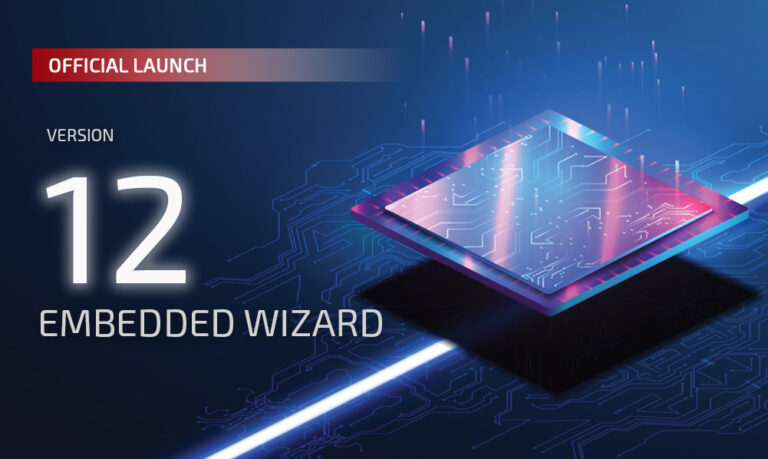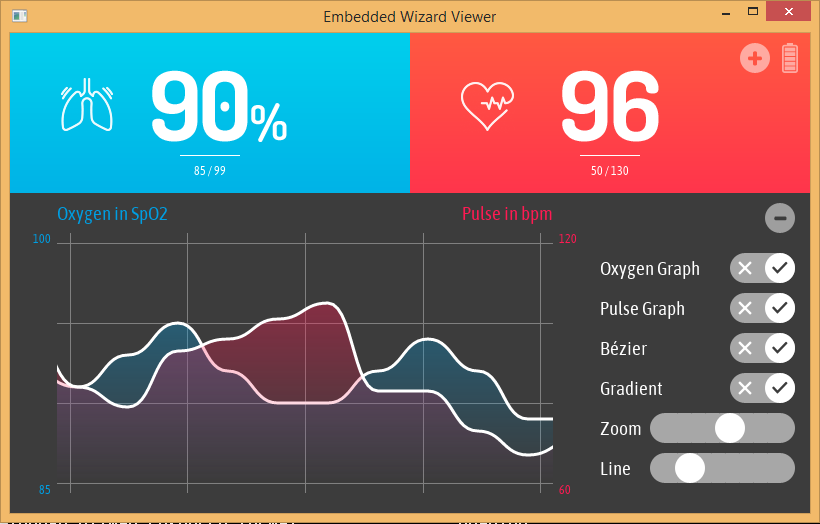

Highlights of Embedded Wizard 12
With the new version Embedded Wizard 12, you deliver some improvements and innovations to build even more diverse GUIs and make the workflow and architecture setup easier and time-saving for software engineers. As far as UX design is concerned, eye-catching HMIs and intuitive user experiences in terms of graphical effects and representations are becoming increasingly important, and the trend is also moving in this direction. To what extent does the Embedded Wizard tool take this development into account?
We are always on the lookout for design trends that are on the market—for example, smartphones or any mobile devices. As consumers, we are used to having the latest version of these. For instance, the effect of background blurring, when it comes to pop-up windows or similar applications on our devices. This blurring feature to change the background or similar use cases has found its way into the latest version of Embedded Wizard.
Also, shadow effects are now supported, e.g., to turn the current view into a copy and make it more like a black-and-white scheme or like an effect of natural shadow at night on the street. In addition to the graphical features, we’ve also added features that enhance our vector graphics capabilities. These, in combination with blurring and shading, provide a new functionality and can be met for new UI design requirements, i.e. masking. This is a big improvement in the latest version of Embedded Wizard. New requirements can be considered and implemented in customers’ next UI projects.


Talking about design and trends: Moving images, but also short videos, are of great importance for addressing users, conveying and displaying information on digital interfaces, with an increasing tendency. What possibilities does Embedded Wizard 12 offer in this respect?
If you look at the whole history of Embedded Wizard and at where we’ve come from, we’ve always been involved in video topics: We started in consumer electronics and to be precise in the area of televisions and set-top boxes. For us, the next logical step was to offer more and support a better integration of external video components and sources into the GUI world. This allows customers to include video streams in the UI and customize them according to their design preferences. More than just full-screen video is possible: You can for example scale, rotate, or do some kind of perspective transformations with videos and even add multiple sources in parallel.
Of course, the underlying hardware must support this kind of video decoding feature. For those that don’t, we provide software routines to achieve at least a small amount of video playback functionality. So, this is a big step for us, mainly because of customer requests we received that we can now address.
When it comes to the now–released extension of the Windows Platform Package, can you give deeper insights on the main benefits here for the user to take up the offer?
We have been supporting the Windows environment since the early days of Embedded Wizard. However, that support was not designed to be very comprehensive until now. Of course, there were built-in examples, but it was neither well documented nor was the same approach followed we are foreseeing with all the other embedded platforms.
Now, with Embedded Wizard 12, we’ve worked that out and put the Win32 Platform Package in the same scheme as the other Platform Packages. This means that you now have the opportunity to get the source code, sophisticated documentation, and various examples. In addition, it is now configurable like other platform set-ups. Of course, this added value now follows the same licensing model as we do with the embedded Platform Packages. For those that now might ask: Yes, a pure Linux Desktop Platform Package is now available as well.

To conclude, let’s talk about a pervasive topic: The industry situation in terms of chip supply. It is already known that the current market situation is characterized by supply bottlenecks and a general chip shortage. This makes it difficult for manufacturers to predict production processes and is subject to inaccurate forecasts. What advantages does the Embedded Wizard team offer to them by expanding to other platforms like STMicroelectronics, NXP, Renesas, Infineon or GigaDevice?
Platform dependency can be a nightmare. One of the core design principles of Embedded Wizard is to be platform-independence and agnosticism. For that, we laid down the base to support those new platforms you referred to with the next Embedded Wizard Version. That means we already have the latest releases of upcoming processors from different semiconductors manufacturers, as far as we know, to be able to put into the supply chain. Those upcoming devices will now be supported with Embedded Wizard 12. That means customers can now already start with new platforms and graphic engines inside the hardware out of the box – even if the desired hardware is not yet available. Overall, this sums up why we have done our best to achieve that Embedded Wizard 12 provides customers with sustainable value and real benefits, especially considering the current market situation.
